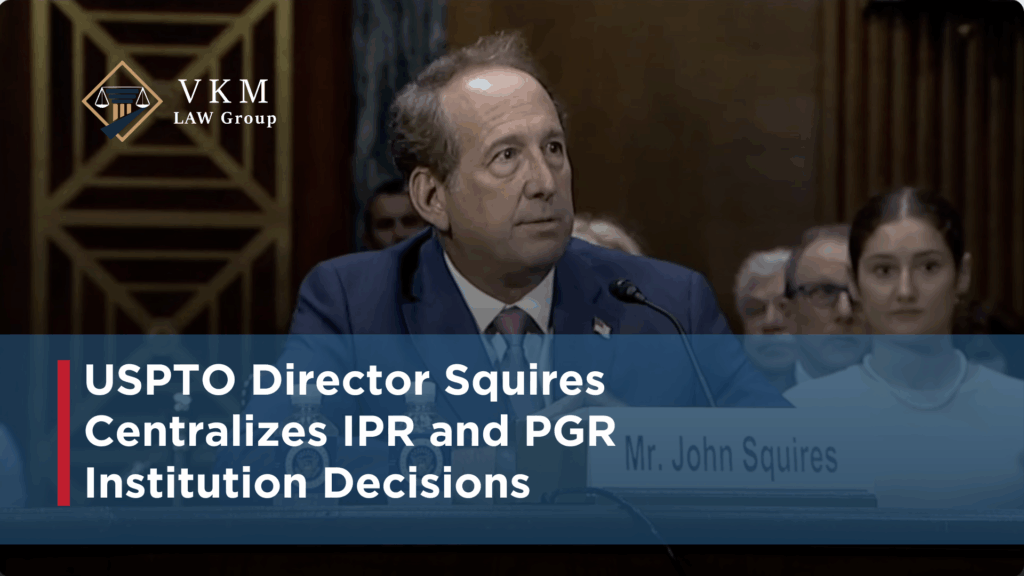
In a sweeping move to reshape the U.S. patent system’s approach to trial institutions, newly appointed USPTO Director John A. Squires has taken direct control over the decision to institute inter partes review (IPR) and post-grant review (PGR) proceedings. This policy shift—announced in a memorandum to Patent Trial and Appeal Board (PTAB) judges last Friday—marks a decisive effort by the Trump Administration to reassert executive oversight over a key element of the America Invents Act (AIA) process.
Director Squires Takes Direct Aim at PTAB’s Autonomy
In his October 18 memo to all PTAB administrative patent judges (APJs), Director Squires outlined that all institution decisions for IPR and PGR trials will now be issued directly by the USPTO Director, following consultation with at least three PTAB judges.
This change aligns with ongoing policy efforts to restore balance and transparency to AIA trial proceedings, particularly amid criticism that the PTAB has historically favored institution and invalidation at the expense of patent owners.
According to Squires’ open letter accompanying the memo, the move is intended to combat perceptions that the PTAB is “filling its own docket,” and to dispel public doubts about the impartiality and incentives of the Board. Squires emphasized that the Director’s statutory authority under 35 U.S.C. § 314(a) (IPR) and § 324(a) (PGR) is non-exclusive and may be reclaimed—a key legal basis for his decision.
Why This Matters: A Shift in PTAB Power Dynamics
This development is significant for both patent challengers and patent owners. Previously, PTAB APJs made most institution decisions, which led to criticism of high institution rates and excessive invalidation. Director Squires’ decision represents an executive-level reassertion of control over PTAB trial initiation, likely resulting in:
- Fewer institutions of IPRs/PGRs against granted patents.
- More transparency and consistency in threshold determinations.
- Stronger alignment with pro-patent policy objectives.
The memo builds on a temporary process implemented in March 2025 under Acting Director Coke Morgan Stewart, who had begun centralizing discretionary denial decisions. Now, that framework is being expanded to all institution decisions.
The Broader Political Context: Trump Administration’s Patent Policy
Since the beginning of the second Trump Administration, the USPTO has undergone a pro-patent procedural transformation. Under Acting Director Stewart and now Director Squires, key reforms have aimed at improving procedural fairness for patent owners, particularly at the PTAB.
Earlier reforms emphasized:
- Respect for settled expectations of patent owners.
- Addressing employment and pendency issues in the PTAB.
- Shifting away from automatic institution of IPRs based on volume and statistical tendencies.
Director Squires has also voiced concerns during his confirmation process about the imbalance between IPR vs. PGR proceedings, and the high invalidation rates observed in PTAB proceedings. These concerns appear to have shaped the current policy change.
What This Means for Patent Owners and Petitioners
For Patent Owners:
- Stronger institutional protection of granted patents.
- A higher threshold for PTAB trial initiation.
- Greater predictability and centralization in decision-making.
- Opportunity to strategically push for discretionary denial under consistent review.
For IPR Petitioners:
- Expect a tougher path to institution.
- Summary decisions may be less detailed, making it harder to assess weaknesses.
- Legal challenges under the Administrative Procedure Act (APA) likely face an uphill battle, especially given Supreme Court precedent limiting judicial review (e.g., Cuozzo and Thryv decisions).
The Legal Landscape: Summary Decisions, Limited Appeal Rights
Under this new process, institution decisions will be issued in summary form, following consultation with three APJs. In high-profile or novel cases, the Director may delegate portions back to APJs for deeper analysis.
Importantly, even under this new structure, petitioners will find it difficult to appeal a denial of institution. The U.S. Supreme Court has interpreted 35 U.S.C. § 314(d) as a strong bar against judicial review of these decisions, giving the Director wide latitude in exercising discretion.
VKM Law Group’s Perspective: A New Era for PTAB Strategy
As a leading Intellectual Property law firm in New Jersey, VKM Law Group sees this policy shift as a potential turning point for patent protection in the U.S., particularly for small businesses, startups, and individual inventors often vulnerable to PTAB challenges.
If you are:
- A patent owner concerned about an IPR challenge…
- A business with pending patent litigation…
- A startup looking to secure your IP assets against attack…
…you should reassess your legal strategy in light of this centralization of institution decisions.
Key Takeaways
- Director Squires now personally oversees all IPR and PGR institution decisions.
- The change is intended to restore public trust and limit the PTAB’s perceived institutional bias.
- Fewer institutions and more predictability are likely, especially for strongly drafted patents.
- Legal challenges to this framework will likely fail, given the discretion afforded to the USPTO Director under existing law.
- Patent owners should consider this an opportunity to reassess their PTAB defense strategies.
Looking to protect your patents from IPR risk?
Contact VKM Law Group — your New Jersey-based Intellectual Property Attorneys. We help innovators defend what they’ve built and adapt to the ever-changing IP legal landscape.